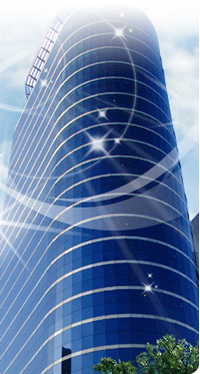
Construction Sites Temporary Fencing in Ensuring Safety, Security, and Organization
Temporary fencing plays a crucial role in ensuring the safety, security, and organization of construction sites. It acts as a barrier to protect workers, pedestrians, and property from potential hazards associated with construction activities. Additionally, it helps in delineating site boundaries, preventing unauthorized access, and safeguarding materials and equipment.
Application Scenarios: Used for general construction sites, municipal projects, and other construction zones to isolate the worksite and protect workers and the public.
Common Dimensions for Temporary Fencing
1. Height
- Standard Heights:
- 4 Feet (1.2 meters): Most commonly used for general construction site fencing, providing adequate visibility and security.
- 3 Feet (0.9 meters): Suitable for areas requiring lower barriers, such as pedestrian walkways adjacent to construction zones.
- 6 Feet (1.8 meters): Used for high-security sites or areas needing enhanced privacy and protection.
2. Panel Length
- Standard Lengths:
- 8 Feet (2.4 meters): The most widely used panel length, offering flexibility in configuring the fencing layout.
- 6 Feet (1.8 meters): Useful for shorter sections or areas with space constraints.
- 10 Feet (3 meters): Employed in larger areas to reduce the number of panels required, simplifying installation and maintenance.
3. Post Dimensions
a. Square Posts
-
Dimensions:
- 1.5 Inches × 1.5 Inches (38 mm × 38 mm): Standard size providing a sturdy framework for most temporary fencing applications.
- 2 Inches × 1.5 Inches (50 mm × 38 mm): Offers increased strength and stability, especially for taller or high-security fencing systems.
b. Rectangular Posts
- Dimensions:
- 2 Inches × 1.5 Inches (50 mm × 38 mm): Commonly used for applications requiring additional strength and stability.
- Features:
- Increased Strength: Ideal for high-wind areas or sites with heavy fencing panels.
- Enhanced Stability: Suitable for extended fencing systems where durability is paramount.
c. Round Fence Posts
-
Dimensions:
- Diameter:
- 2 Inches (50 mm): Standard diameter offering a balance between strength and ease of installation.
- 3 Inches (76 mm): Provides additional strength for high-security or high-wind areas.
- Height:
- Typically 6 Feet (1.8 meters): Extends below ground level to ensure stability.
- Diameter:
4. Top Rail Dimensions
- Standard Sizes:
- 1.5 Inches (38 mm) Round or Square Rail: Commonly used for attaching panels and providing structural support.
- 2 Inches (50 mm) Square Rail: Utilized in high-security fencing for added strength.
5. Gates and Accessories
- Gate Heights and Widths:
- Typically match the fence height (e.g., 4 feet) and vary in width based on access requirements, commonly ranging from 3 feet to 6 feet wide.
- Locks and Fasteners:
- Ensure compatibility with post and panel dimensions for secure installation.
6. Material Thickness
- Panel Wire Gauge:
- 12 Gauge (2.05 mm): Offers a balance between strength and flexibility for general use.
- 10 Gauge (3.41 mm): Provides increased durability and security for high-risk sites.
- Post Thickness:
- 2.5 Inches (63.5 mm) or greater: Recommended for sites requiring enhanced stability and resistance to tampering.
- Base/Feet: Options include:
- Concrete Feet: Providing substantial stability. Specify dimensions and weight.
- In-ground Posts: Embedded in concrete footings for permanent or semi-permanent installations. Specify depth of embedment.
- Connection Method: Clamps, bolts, or welded connections. Specify the connection method for secure assembly.
- Installation Details: Ensure level ground for placement. Secure posts and panels to prevent displacement. Consider wind loading and add bracing if necessary. Use appropriate signage to warn of hazards.
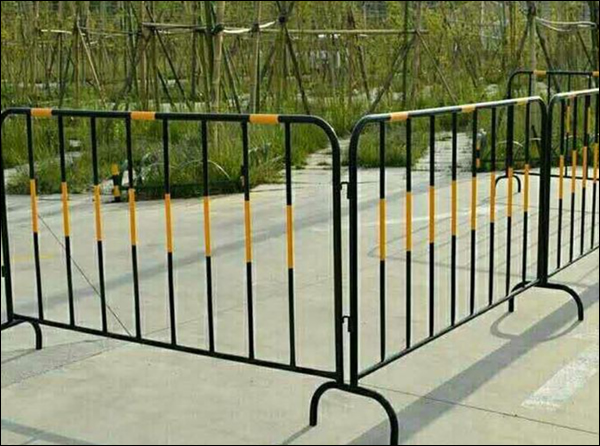
Event Barrier can be used on construction sites for specific purposes like pedestrian walkways, their primary function is crowd control and pedestrian management.
Features:
- Steel Construction: Durable steel tubing.
- Powder-Coated Finish: Weather-resistant black finish.
- Interlocking Design: Hooks and loops for connecting barriers.
- Flat Feet: Stable base with minimal tripping hazard.
- High-Visibility Stripes: Yellow or orange for enhanced visibility.
Specifications:
- Height: Approximately 1 meter (39 inches or 3.2 feet).
- Width: Usually 2 meters (6.5 feet).
- Frame Tubing: Typically 1.5 inch (38mm) or 2 inch (50mm) diameter.
- Infill Bars: Usually 1 inch (25mm) or 1.25 inch (32mm) diameter.
Why they might be used on a construction site:
- Creating safe pedestrian walkways: Guiding workers or visitors around hazardous areas.
- Forming temporary queues: For access control or material handling.
- Restricting access to specific zones: Within the construction site.
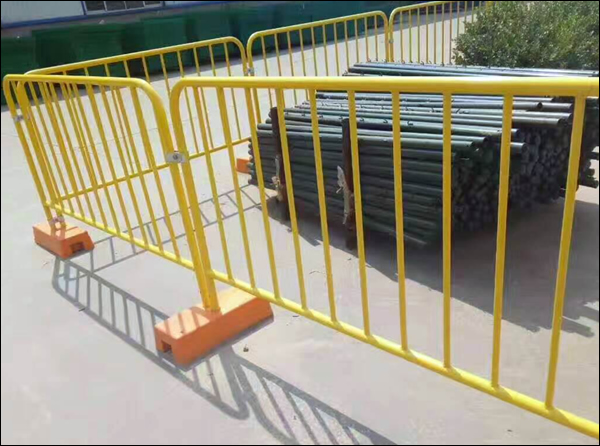
Pedestrian Barrier,
Crowd Control Barrier,
Event Barrier,
Queue Barrier
Features
- Steel Construction: Made of steel tubing for strength and durability.
- Powder-Coated Finish: The black finish provides weather resistance and a professional look.
- Interlocking Design: These barriers usually have hooks and loops or other mechanisms that allow them to be connected together to form a continuous line.
- Flat Feet: The flat feet provide stability and prevent the barrier from tipping over. They are also designed to minimize tripping hazards.
- High-Visibility Stripes: The yellow or orange stripes enhance visibility, especially in low-light conditions or crowded environments.
- Mesh vs. Bars: Construction fence panels typically use welded wire mesh, while pedestrian barriers use vertical bars.
- Stability: Pedestrian barriers rely on their interconnected design and flat feet for stability, while construction fence panels usually require more substantial bases or bracing.
Typical Specifications:
- Height: 1 meter (39 inches or about 3.2 feet).
- Width: 2 meters (6.5 feet).
- Frame Tubing: Usually 1.5 inch (38 mm) or 2 inch (50 mm) diameter steel tubing.
- Infill Bars: Usually 1 inch (25mm) or 1.25 inch (32mm) diameter steel tubing.
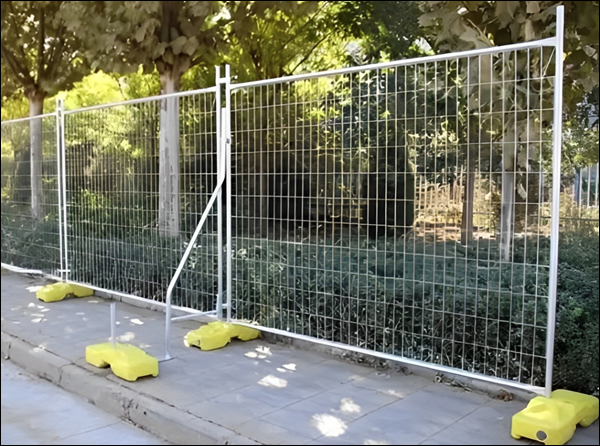
Temporary Fencing used on Construction Sites
Typical Specifications
- Height: Most commonly 6 feet (1.8 meters)
- Width: Usually 10 feet (3 meters) or 12 feet (3.6 meters)
- Mesh Size: Typically 2 inches x 4 inches (50mm x 100mm)
- Frame Tubing: Usually 1 3/8 inch (35mm) or 1 5/8 inch (40mm) diameter steel tubing
Why this type of fencing is popular
- Welded Wire Mesh: The fencing material is made of steel wires welded together to form a grid. This is generally stronger and more rigid than traditional chain link for temporary applications.
- Galvanized Finish: The silver/grey color indicates a galvanized finish, which protects the steel from rust and corrosion.
- Frame: The mesh is welded to a steel frame for added strength and stability.
- Feet/Bases: These are typically concrete blocks, plastic feet (like the yellow ones in the picture), or metal stands that provide support and keep the fence upright.
- Bracing: The angled support in the picture provides extra stability, especially for longer runs of fencing or in windy conditions.
- Easy to install and dismantle: Panels are connected with simple clamps or hooks.
- Portable: Can be easily moved and reconfigured as needed.
- Durable: Galvanized finish provides good weather resistance.
- Cost-effective: A relatively inexpensive way to secure a construction site.
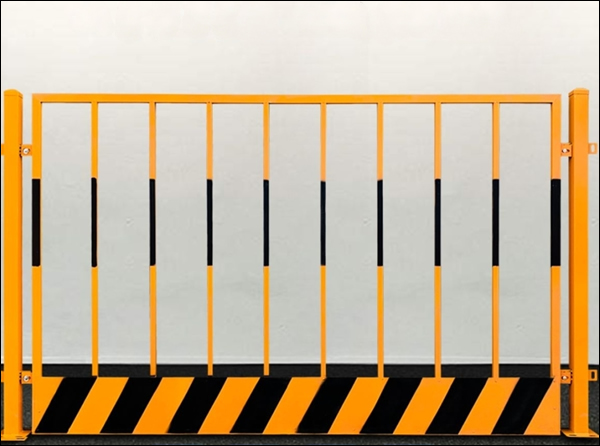
Steel Pedestrian Barrier used for Temporary Fencing on Construction Sites.
- Steel construction: For durability and strength.
- Powder-coated finish: The orange color provides high visibility and may offer some weather resistance.
- Interlocking design: These barriers often have hooks or loops that allow them to be connected together to form a continuous fence.
- Weighted bases or feet: To provide stability and prevent tipping.
- Reflective tape: The black stripes enhance visibility, especially in low-light conditions.
- Height: 1 meter (3-4 feet)
- Width: 2-2.5 meters (6-8 feet) per section
